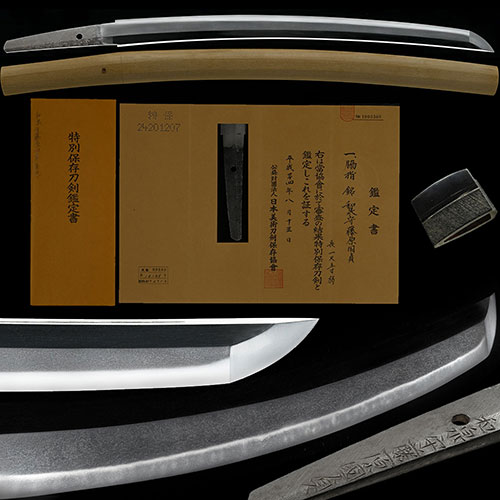
国貞 脇差 Kunisada Wakizashi
No.762203和泉守藤原国貞 身幅3.3cm 精良で美しい地鉄に広直刃足葉入る健全最高傑作 一尺五寸Izuminokami Fujiwara Kunisada Mihaba 3.3cm, Hiro-suguha to the exquisite and beautiful Jigane, There are Ashi and You, Kenzen, A masterpiece 45.4cm
ご成約Sold
- 銘表Mei-Omote
- 和泉守藤原国貞和泉守藤原国貞 Izuminokami Fujiwara Kunisada
- 登録証Registration
- 大阪府 Osaka 昭和30年2月1日 2/1/30(Showa)
- 時代Period
- 慶安頃Around Keian
- 法量Size
-
刃長 45.4cm (一尺五寸) 反り 45.4cm
元幅 1.2cm 先幅 3.3cm 元重 2.3cm 鎬厚 0.75cm 先重 0.55cm 鋒長 3.1cm 茎長 13.7cm 重量 500gHachou 45.4cm (一尺五寸) Sori 45.4cm
Moto-Haba 1.2cm Saki-Haba 3.3cm Moto-Kasane 2.3cm Shinogi-Thikess 0.75cm Saki-Kasane 0.55cm Kissaki-Chou 3.1cm Nakago-Chou 13.7cm Weight 500g - 国Country
- 摂津Settsu
- 姿Shape
- 鎬造、庵棟、身幅広く、反り尋常、中鋒詰まる。Shinogidukuri, Iorimune, Wide Mihaba, Standard Sori, Chu-Kissaki-tsumaru.
- 鍛Kitae
- 杢目肌つみ、板目肌・小杢目肌交じり、地沸微塵に厚くつき、地景細かくよく入り、鉄明るく冴える。Mokumehada-tsumi, Itamehada, Mixed small^Mokume, Jinie entered fine and thick, Chikei entered finely well, Iron is bright and clear.
- 刃文Hamon
- 広直刃、僅かに小互の目交じり、足・葉よく入り、小沸深くよくつき、匂口明るい。Hirosuguha, Slightly mixed small-genome, There are many Ashi and You well, Small-Nie entered deeply, Nioikuchi is bright.
- 帽子Boushi
- 直ぐに小丸。SuguniKomaru
- 茎Nakago
- 生ぶ、先栗尻、鑢目大筋違、目釘孔一。Ubu, Sakikurijiri, Yasurime-ohsujikai, Mekugiana is one(1)
- ハバキHabaki
- 赤銅一重。Single layer of shakudo
- 説明Drscription
- 初代和泉守国貞は、天正十七年(1589年)に日向で生まれ、後に上京し親戚と伝わる堀川国広の門となるが、国貞の初期の作風や銘振りから見て、兄弟子である越後守国儔から指導を受けたと思われる。慶長十九年(1614年)国貞二十五歳の時に師である国広が亡くなり、その後同門である初代河内守国助と共に大坂へ移住し大阪新刀の礎を築き、元和九年(1623年)に和泉守を受領している。初二代共に和泉守国貞と銘を切ることから、初代国貞を通称親国貞、二代国貞を真改国貞と呼んでいる。慶安五年六十三歳没。真改は、名を井上八郎兵衛といい、寛永7年(1630年)、初代国貞の次男として日向国木花村木崎にて生まれ、9歳より当時京都に居た父の下に赴き作刀を学び始め、20歳ごろには盛んに父の代作を行ったといわれ、慶安5年(1652年)、24歳で父の死去に伴い国貞を襲名、同年に「和泉守」を受領、万治四年頃に朝廷より菊紋を茎に切ることを許され、寛文12年(1672年)8月より「真改」と名を改め、銘を「井上真改」と切るようになる。10年後の天和二年に五十三歳で急逝している。この刀は、3.3cmと身幅広く、反り尋常、鋒詰まりごころの堂々とした体配で、杢目交に、地沸微塵に厚くつき、地景よく入り、明るく冴える精良で美しい地鉄に、広直刃に、足・葉よく入り、匂口明るく、頗る健全で出来が良い。銘は、藤代刀工辞典の真改代銘に近似しており、地刃の出来からも真改代作代銘と思われる最高傑作である。The first Izuminokami Kunisada was born in Hinata in 1589, and later moved to Tokyo to become the gate of Kunihiro Horikawa, who was handed down to his relatives. It seems that he received it. Kunihiro, a teacher, died at the age of 25 in 1614, and then moved to Osaka with the first Kouchinokami Kunisuke, who was a member of the same family, to lay the foundation for the new Osaka sword, and in 1623. I have received Mamoru Izumi. Since both his first and second generations are named Izuminokami Kunisada, the first Kunisada is commonly known as Oya Kunisada, and the second Kunisada is called Shinakai Kunisada. He died at the age of 63 in the 5th year of Keian.
Shinkai, whose name is Hachirobei Inoue, was born in Kizaki, Kuniki Hanamura, Hyuga Province in 1630 as the second son of the first Kunisada. It is said that he began to learn and actively performed a substitute work for his father around the age of 20. Around the 4th year, the imperial court allowed him to cut the chrysanthemum crest into stems, and from August 1672, he changed his name to "Shinkai" and changed his name to "Shinkai". He died suddenly at the age of 53 in the second year of Tenna, ten years later.
This sword has wide 3.3cm Mihaba, Standard Sori, Kissaki-tsumarigokoro, and a dignified body with mixed Mokume, Jinie entered fine and thickly, Chikei entered well, It has a bright and clear a beautiful Jigane, Hiro-suguha, There are many Ashi and You. Nioikuchi is bright and Kenzen it works good.
Mei is similar to Shinkaidaimei in the Fujishiro Swordsmith Dictionary. Judging from Jiba's performance, it is a masterpiece that seems to be a true Kaidai version.


